 BACKGROUND BACKGROUND |
Rwanda is a landlocked country measuring 28.000
km² in size and is inhabited by 7 million
people. It is one of the most densely populated
countries in the world. Air transport is indespensable
to the socio-economic and political development
of the country.
Kigali International Airport is the gateway to
the outside world. The airport has regional, national
and International Strategic Significance. It is
one of 17 airports identified by the ECA as a
future hub network on the African Continent. The
authorities in Rwanda recognises the crucial importance
of Kigali International (KIA) and are making efforts
to improve its airport infrastructure and air
navigation facilities with a view to maintain
ICAO standards.
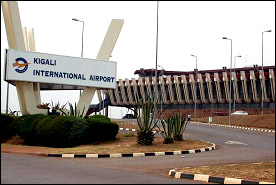
 The
Situation Prior to 1980 The
Situation Prior to 1980 |
The decision to rehabilitate the Kigali-Kanombe
Airport dates back from December 1977, when preliminary
estimates for the required conversions to enable
the runaway to accommodate the Boeing 747 were
drawn up under arrangements by two Ministries:
on one hand the one responsible for Transport
and Communications, and on the other, the one
responsible for Public Works.
The works envisaged, estimated at US$ 2,300,000,
consisted of transorming the runway so that it
would comply with OACI standards. The following
was to be carried out:
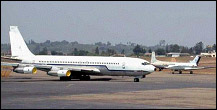
- Construction of Anti-Blast strips that would
protect against soil removal by the blast from
airplane engines;
- Construction of a reversal point at each
extreme end of the runway;
- Extension of the airplane parking area
In May 1978, Rwanda submitted to France a
request for funding of the construction of
a new Air Terminal, in the framework of a
program to rehabilitate the Kigali-Kanombe
Airport.
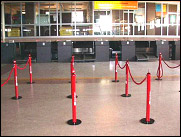
In response to the request of the Rwandan authorities,
the Société Française d'Etudes
et de Réalisation d'Equipements Aéronautiques,
SOFREAVIA, had submitted a Study Proposal, and
the final, approved deal was signed on 6th October
1978.
The Study entrusted to SOFREAVIA was to last
for a period of six months and was supposed to
culminate with the presentation of a detailed
pilot study that would facilitate the submission
of bids by interested companies. The draft project
was also supposed to be in keeping with the requirements
of potential donors; therefore it was to include
an economic and financial assessment. The project
had the following objectives:
- To establish a general plan for the rehabilitation
of the Airport
- To draw up in detail the first phase of rehabilitation
that would facilitate the accommodation of long-distance
aircraft, wide-bodied aircraft, and cargo handling
- To estimate the cost of construction works,
as well as its effect on airport revenue and
the cost of Airport operations
These construction works included the establishment
or strengthening of infrastructures, the construction
of buildings including a Hydrocarbons' Warehouse
as well as the supplying and installation
of electric and electronic equipment.
The 1994 war that affected many of the country's
infrastructures did not spare the Régie
des Aéroports du Rwanda (RAR).
Thus after this war, the RAR fixed itself
the target of rehabilitating its infrastructures,
namely:
The Passenger Terminal, the Technical Unit,
and the Power Station, the runway drainage
system, parking area for vehicles, and areas
that were damaged by shrapnel.
Apart from infrastructures, some equipment
to assist aerial navigation, telecommunications
as well as the Air Terminal electronic equipment
were replaced. They included the following:
- The VOR and DME
- VHF transmitters and receivers used by the
control tower to communicate with aircraft
- Aeronautic communications recording equipment
- Passenger and luggage search equipment
- Electronic weighing machines for luggage
It is anticipated that there shall be, in
the near future, a project to rehabilitate
the Airport that is funded to the amount of
22 million Euros (22,000,000 Pounds Sterling)
by the European Investment Bank (EIB) and
the European Development Fund (EDF).
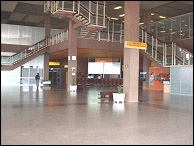
The results of the completed preliminary study
anticipate the following:
- Reinforcement of the runway and the aircraft
parking area through the fitting out of an extra
7 cm-layer of bituminous concrete
- Widening of the entrance/exit ramp, the 'reversal
area' and the stretching of both of the extreme
ends of the runway, in order to accommodate
larger or heavier aircraft, or commercial aircraft
such as the A 330-600 and the B 777-300
- Extention of the aircraft parking area
- Construction of an aircraft circulation area
parallel to the runway, to allow aircraft to
access the aircraft parking area
- Rehabilitation of the fire hydrant and increase
of revitalisation outlets within the aircraft
parking area.
- Rehabilitation of service routes
- Review of all drainage systems within the
entire airport area
- Replacement of the ILS
- Connection of the SADC on VSAT network, to
facilitate AFTN and ATS/DS communications
- Rehabilitation of the FIDS (Flight Information
Display System) system
- Installation of approaching lights
- Installation of runway lights
- Establishment of three rescue teams, and
three sub-power stations for a better energy
supply to airport equipment
- Thourough rehabilitation of the power station,
i.e. from the medium-voltage section to the
low-voltage distribution chamber
- Installation of a computerised monitoring
and instructions system for the electric network
- All these work activities were divided into
Eight Phases in the following manner:
Phase A: Comprised activities dealing with
the surface and with sanitation, namely:
- Strengthening of the runway whose life-span
should normally be a minimum of 15 years for
a traffic estimated at 17,000 movements by wide-bodied
aircraft weighing between 230 and 330 tons and
38,000 movements by other kind of aircraft weighing
between 50 and 130 tons;
- Construction of Anti-Blast strips and the
widening of the reversal point;
- Strengthening of the existing aircraft parking
area currently measuring 21,000 m2 and construction
of its northern extension measuring a surface
area of 37,000 m2.
Phase B: Included the construction of two
buildings; the power station and the warehouse
measuring up to 820 m2; and to transfer the
Hangar for light aircraft towards the southern
end of the runway.
Phase C: Icluded the construction of a Hydrocarbons'
warehouse with a capacity of 1,750 m3.
Phase D: Included the supplying and installation
of electric equipment including equipment
for the power station, as well as construction
works for the runway lights and lighting in
general
Phase E: Included the construction of a new
Air Terminal with a surface area of 7,750
m2 of three floor levels, with a ground floor
measuring 3,600 m2 designed to accommodate
400 passengers per hour.
Phase F: Included the supplying and installation
of electronic equipment for aeronautic telecommunications,
and radio-based assistance to aerial navigation,
mostly comprising the construction of a broadcasting
centre.
An additional phase: related to outside parking
spaces and various road and other networks
of the Air Terminal
Three parking areas whose installation was
totally carried out by the Rwandan Government,
and which signify the latter's participation
in the program as a whole.
Lastly, still within the framework of the
same rehabilitation program, a study on the
organisation and management of the Kigali
Airport was carried out by AEROPORTS DE PARIS.
The total cost of the entire program amounts
to US$ 35,000,000 and was funded respectively
by the Rwandan Government on one hand, and
Belgium, France, Abu Dhabi, OPEC, and Koweit
on the other hand.
 ESTABLISHMENT
OF THE REGIE DES AEROPORTS ESTABLISHMENT
OF THE REGIE DES AEROPORTS
Régie des Aéroports du Rwanda
was established by a Presidential Order, N°
32/12 of January, 1986 for the purpose of
management, operation and maintenance of the
airports in Rwanda. Régie des Aéroports
du Rwanda has no legal personality or corporate
autonomy.
Table
about flights |
Any legal procedure
against the Régie has to be taken directly
against the government. The director of the Régie
is appointed to do every day management of the Régie.
It also develops, maintains and operates airports
infrastructure and air navigation facilities. The
Régie has financial and technical autonomy.
Any profit is invested in RAR needs. Régie
can do commercial and financial operations as may
be required to realise its objectives. The director
of the Régie is appointed to do every day
management of the Régie
International passengers Flow at Kigali International
Airport by Calendar years 1992-2001
 REHABILITATION
OF THE AIRPORT AFTER 1994 REHABILITATION
OF THE AIRPORT AFTER 1994
La guerre de 1994 qui a touchée beaucoup
d'infrastructures du pays n'a pas laissé
la Régie des Aéroports du Rwanda
(RAR).
C'est ainsi qu'après cette guerre, la RAR
s'est donné l'objectif de réhabiliter
ses infrastructures, à savoir :
L'aérogare pour passager, le bloc technique
et la centrale électrique
des purges dans la piste et au parking automobile
aux endroits endommagés par les éclats
des obus.
A part les infrastructures, quelques équipements
d'aide à la Navigation aérienne,
de télécommunication ainsi que les
équipements électroniques de l'aérogare
ont été remplacés. Ce sont
entre autre :
le VOR et le DME
les émetteurs et récepteurs VHF
utilisés par la tour pour communiquer avec
les avions
l'enregistreur des communications aéronautiques
les équipements de fouille passagers et
bagages de l'aérogare.
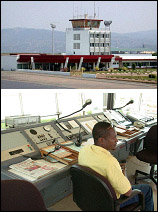
Les balances électroniques pour l'enregistrement
des bagages
Dans un proche avenir commence un projet de réhabilitation
de l'Aéroport financé de 22 millions
d'Euros ( 22.000.000 € ) par la Banque Européenne
d'Investissement et le FED (Fonds Européen
Dévloppement ).
Les résultats de l'étude déjà
terminé prévoit:
Le renforcement de la piste et de l'aire de stationnement
par ressurfaçage d'une couche de 7 cm de
béton bitumineux
l'élargissement de la bretelle, des aires
de retournement et le prolongement d'arrêt
aux deux extremités de piste pour tenir
compte des avions les plus pénalisants
ou prochainement commerciales comme
l' A 330-600 et le B 777-300.
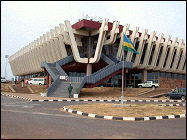
L'implantation d'un nouveau glide
L'extention de l'aire de stationnement
La construction d'une voie de circulation parallèle
à la piste pour faciliter les aéronefs
à accéder dans l'aire de stationnement
La réhabilitation de l'hydrante et l'augmentation
des bouches de ravitaillement dans l'aire de stationnement.
La réhabilitations des routes de service
La révision du système de drainage
de toute la zone aéroportuaire
Le remplacement de l'ILS
La connection sur le réseau VSAT de la
SADC pour des communications AFTN et ATS/DS.
La réhabilitation du système FIDS
(Flight Information Display System )
L'implantation des lampes d'approche
Le remplacement des balises
L'installation de trois groupes de secours et
création de trois sous-stations pour mieux
alimenter en énergie les équipements
aéroportuaires.
La réhabilitation entière de la
centrale électrique c-à-d de la
cellule moyenne tension jusqu'à l'armoire
de distribution basse tension.
Installation d'un système de contrôle
et de commande par ordinateur du réseau
électrique.
International overflights through Kigali Airspace
management from 2000-2001
Table
about number of overflights
 FACILITIES
AND SERVICES OF THE REGIE FACILITIES
AND SERVICES OF THE REGIE
The Civil Aviation in the country has 7 Airports
:-
i) Kigali International Airport - Runway 3500m
x 45m
ii) Kamembe Aérodrome - Runway 1500m x
25m
iii) Gisenyi Aérodrome - Runway 1000m x
23m
iv) Ruhengeri Aérodrome - Runway 1480m
x 35m
v) Butare Aérodrome - Runway 860m x 25m
vi) Nemba Aérodrome - Runway 1100m x 25
m
vii) Gabiro Aérodrome - Runway 760m x 25m
(non functional)
Kigali Airport is the only International Airport.
Out of the other six Aérodromes, only two
i.e Kamembe and Gisenyi have some schedulled traffic.
 CIVIL AVIATION
SYSTEM IN RWANDA CIVIL AVIATION
SYSTEM IN RWANDA
Administration and Management of Civil Aviation
in Rwanda is done by Régie des Aéroports
du Rwanda and Aéronautique Department in
the Ministry of Public Works, Transport and Communications.
The department of Aéronautiques provides
the regulatory aspects of Civil Aviation and oversees
their application while Régie des Aéroports
du Rwanda provides essential Infrastructure, Installation
facilities and services for Civil Aviation in
order to meet its mandate of providing safe, efficient
and secure Air Transport Services.
Total cargo and total mail from 1992-2001
Table
about total cargo, and total mail.
 CURRENT ORGANISATION
OF RAR CURRENT ORGANISATION
OF RAR
The organisational structure shown in exhibit
1 has undergone changes since the establishment
of the Régie in 1986. A summary of the
current structure is shown here below :
a) Office of the Managing Director 1
· Public Relations 1
· Secretariat Section 7
· Research and Planning Section 1
· Technical Aircraft Audit Section 3
· Internal Audit 3
· Resources Renewal & Recycling Sect.
6
· Kamembe Airport 23
· Information Technology 4
b) Marketing and Business Development Dep. 13
c) Administration and Finance Dept. 47
d) Operations Department 104
e) Installations and Maintenance Dept. 81
f) Domestic Airports 14
TOTAL 298
 CREATION
OF CIVIL AVIATION AUTHORITY CREATION
OF CIVIL AVIATION AUTHORITY
Recently, International Civil Organisation (ICAO)
do recognise the importance of countries to have
Civil Aviation Authorities. This helps authorities
to adopt acceptable and recognised commercial
business practices and also organised and managed
as autonomous entities. Therefore it is within
this framework that the Government of Rwanda Commissioned
ICAO to study the possibility of Régie
des Aéroports du Rwanda to become Civil
Aviation Authority.
The strong support by the government for the
creation of an autonomous authority to manage
civil aviation facilities emanates from the recommendation
adopted at the AFCAC Tenth Plenary Session where
it states that:
· Whereas this could improve operational
efficiency and financial results, states consider
establishing autonomous authorities to manage
their major International Airports, route facilities
or both.
· Such authorities be vested with financial
autonomy and sufficient operational and financial
independence and,
· The decision to establish an authority
should be based on a feasibility study identifying
potential improvements in efficiency and financial
results to be gained there from and describing
how these could be realized.
A feasibility study was conducted in accordance
with terms of reference and a recommendation was
made that a Civil Aviation Authority be established.
This has to be in charge of all civil aviation
functions as a parastatal fully owned by the Government
as its sole shareholder. The CAA will be allowed
to function autonomously according to formal business
practices and should be operational by end 2002.
 IMPLEMENTATION
PLAN OF CAA IMPLEMENTATION
PLAN OF CAA
The implementation plan will be carried out in
3 phases, each with its distinct objectives, tasks.
The readiness of each phase passes on to the next
phase.
Phase 1 will last from the point at which the
government of Rwanda formally decides to proceed
with creation of CAA.
· The overall objective of phase I is
to make all provisions in support of the viable
creation of CAA.
Phase II will not last for no more that 1 year
starting from the date on which CAA is legally
in place.
· The overall objective of this phase
is to establish the CAA firmly as an autonomous
decision making entity.
The third phace will last for no more than one
year, starting from the point of completion of
phace II
· The overall objective of phase III is
vigorous pursuit of all opportunities in fulfillment
of the CAA's mandate.
 INTERIOR OF
THE PASSENGER TERMINAL PASSANGER FACILITATION INTERIOR OF
THE PASSENGER TERMINAL PASSANGER FACILITATION
CIP:
Commercial Important Personality
AEROBAR :
Bar and restaurant for both passengers on transit
and the Public.
V.I.P lounge
Duty Free Shops in the passenger terminal

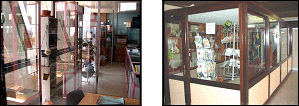
 SECURITY
SCREENING - CABIN LUGGAGE SECURITY
SCREENING - CABIN LUGGAGE
- Computer luggage Screening
- An arch detectors
- Hand held detectors
- Sufficient security personnel
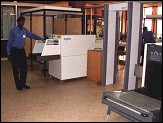
 GATES ON
THE TERMINAL GATES ON
THE TERMINAL
The terminal building has sufficient gates to allow
the passengers more freely. The public area has
8 gates, transit hall has 3 gates, VIP lounge has
1 gate, arrival area has 3 gates.
|

